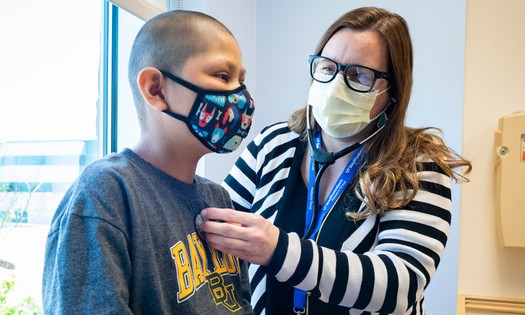
Retinoblastoma is an ocular tumor that affects approximately 300 children in the U.S. every year. Pediatric Ophthalmologists at Children’s Medical Center Dallas, part of Children's HealthSM, partner with the ocular oncology team at UT Southwestern to offer cutting-edge treatments for children with eye cancer – including intra-arterial chemotherapy (IAC).
IAC is an innovative and highly effective treatment for retinoblastoma. This method delivers chemotherapy drugs directly to cancerous eye tumors via a tiny catheter. The treatment significantly reduces the need to perform eye removal surgery and has fewer side effects than systemic chemotherapy.
Intra-arterial chemotherapy is highly complex, requiring a team of experts with specialized skills. Children’s Health and UT Southwestern are among a select few in the country offering this advanced treatment for retinoblastoma.
“Systemic chemotherapy was the former standard of care for retinoblastoma. But there was a high rate of treatment failure, as well as complications like hearing loss and bone marrow suppression,” says J. William Harbour, M.D., Ocular Oncologist at Children’s Health and Professor and Chair of the Department of Ophthalmology at UT Southwestern. “Intra-arterial chemotherapy is much more precise because the medications go straight to the tumor with less exposure to the rest of the body.”
Founding a world-class pediatric ocular oncology program
A world-renowned ocular oncologist, Dr. Harbour joined Children’s Health and UT Southwestern in 2021. He previously served as the Dr. Mark J. Daily Endowed Chair at the University of Miami Health System’s Bascom Palmer Eye Institute, as well as their Director of Ocular Oncology and Vice Chair for Translational Research.
At Children’s Health and UT Southwestern, Dr. Harbour has brought together a team of specialists in pediatric oncology, endovascular neurosurgery, ophthalmology, neuroradiology and clinical genetics to create a world-class pediatric ocular oncology program. The comprehensive, multidisciplinary program offers children with retinoblastoma a full suite of treatment options, including intra-arterial chemotherapy.
A challenging case: Bilateral retinoblastoma
The pediatric ocular ophthalmology team first used intra-arterial chemotherapy in November 2022 when a 9-month-old patient came to Children’s Health after his pediatrician noticed a potential eye problem. The case illustrates the therapy’s benefits.
Exam findings showed the infant had retinoblastoma tumors in both eyes. Bilateral retinoblastoma occurs in about 4 in 10 patients with the diagnosis. Treating tumors in both eyes presents special challenges, particularly when the cancer is advanced.
Systemic chemotherapy
“We typically start with systemic chemotherapy when cancer affects both eyes because it treats all tumors simultaneously,” says Pediatric Retinal Specialist Angeline Wang, M.D. “When cancer affects just one eye, intra-arterial chemotherapy is more effective and can spare a child from chemotherapy side effects.”
The patient was 10 months old when he underwent six rounds of systemic chemotherapy infusions over six months. “The tumors in his left eye responded well and became inactive, whereas those in the right eye initially shrank but then grew back,” says Dr. Wang.
Laser therapy
Dr. Wang also performed several sessions of a type of laser therapy called transpupillary thermal therapy (TTT) on the tumors in the patient’s right eye. The heat from the infrared laser destroys tumor remnants. The use of laser therapy along with chemotherapy (thermochemotherapy) can bolster the chemo drug’s effectiveness.
Intravitreal chemotherapy
To control the cancer recurrence, the team used intravitreal chemotherapy, which involves injecting chemotherapy into the vitreous humor of the eye. Unfortunately, the cancer didn’t respond. “Before intra-arterial chemotherapy, surgically removing the eye was the only way to treat difficult cases like this one and stop the cancer from growing and spreading to the brain,” says Pediatric Retinal Specialist Yu-Guang He, M.D.
Intra-arterial chemotherapy
On November 22, 2022, Rafael de Oliveira Sillero, M.D., a Pediatric Neurosurgeon at Children’s Health, performed intra-arterial chemotherapy treatment on the patient. With the patient under general anesthesia, Dr. Sillero carefully threaded a catheter into the femoral artery in the groin and threaded it up to the ophthalmic artery that enters the eye. He then delivered a highly concentrated dose of chemotherapy directly into the blood vessels that fed the eye tumors.
Additional treatments on February 2, 2023 and March 2, 2023 led to successful inactivation and cure of the eye tumors.
Advanced chemo treatment saves lives and eyes
The patient, now 2 years old, shows no signs of cancer and currently doesn’t wear corrective lenses. Thanks to the team at Children's Health and UT Southwestern, all children with retinoblastomas have a chance at a similar outcome.
Children who receive intra-arterial chemotherapy for Group A to D retinoblastomas have a greater than 90% chance of keeping the affected eye. This is a significantly higher percentage than children who only receive systemic chemotherapy.
Why Children’s Health: Leaders in pediatric ocular oncology
Children’s Health is consistently ranked among the nation’s top hospitals for pediatric oncology and neurosurgery. The specialists in these departments partner with the ocular oncology team to provide advanced treatments for retinoblastoma and other ocular tumors.
In addition to providing leading-edge ocular oncology services, our Pediatric Ophthalmology Department also offers state-of-the-art diagnostic tests and treatments in the fields of neuro-ophthalmology and oculoplastics.
“Our priorities are to first save a child’s life, second preserve their eye, and third retain as much vision as possible,” says Dr. Harbour. “Being able to offer intra-arterial chemotherapy increases our chances of achieving all three goals.”
Learn more about retinoblastoma and the innovative treatments at Children’s Health. >>


